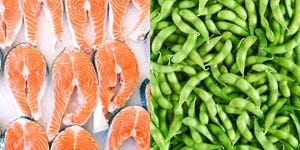
If you’ve tried a low-carb diet like paleo or keto (or just got hangry on a road trip), you’ve likely munched on beef jerky. It’s a super popular—and controversial—food, labeled both a “healthy snack” and a “junk food to avoid” at the same time. So, uh, which is it?
“There are so many different kinds of beef jerky, including many unhealthy varieties,” says Eliza Savage, R.D. at Middleberg Nutrition in New York City. “But more brands are coming to the market with cleaner options that make a great portable, low-carb, and high-protein snack.”
So, whether or not you’re enjoying a healthy snack comes down to what kind of jerky you’re grabbing off the shelf. But with so many brands, it can be hard to decipher which ones are a good choice.
First of all, what exactly is beef jerky?
If you’ve never considered where beef jerky comes from (because, TBH, it’s not the cutest process), get ready for some knowledge. Jerky is made by marinating thin strips of beef in a curing salt solution. Then, the strips are hung on stainless steel sheet, then cooked for 2.5 to 5 hours, according to the process laid out on the People’s Choice Beef Jerky website. All of these steps give jerky a long shelf life.
Jerky is thought to have originated in South America in the 1800s, but new flavors and varieties have exploded in recent years, especially as low-carb diets gain steam.
Just how healthy is beef jerky?
Per the USDA, a typical one-ounce serving of plain beef jerky contains:
“The low fat and carb content make jerky a great source of lean protein,” says Savage, meaning it’s a snack that can fill you up without weighing you down. It’s also a good source of iron, and some varieties contain vitamin A, C, and calcium—usually as a result of the flavorings and preservatives.



The downsides? Because it’s cured, the sodium content is super high. Just one ounce of standard jerky contains around 506 milligrams, according to the USDA—or 22 percent of the FDA’s recommended daily amount (RDA).
Another concern is nitrates—often added to many jerkies as a preservative to prevent harmful bacteria from forming—which have been linked to cancer. The meat in many jerkies is also poor quality. “The packaging can just say ‘beef,’ but this could be any part of the animal and is usually scraps that are unable to be sold for cooking,” says Savage. Um, gross.
And while jerky itself is low-carb, the added flavorings can amp up the carb and sugar content, making the snack more like candy.
So…what type of beef jerky should I eat?
By choosing brands that use grass-fed and organic beef, you’ll be getting more nutrients, and avoiding the whole mystery meat scenario, says Savage. “Look on the label for low-sugar content, and only ingredients you actually know,” says Savage.
Her favorite brands are The New Primal, Epic, Field Trip, Wild Zora, and Mighty Organic.
Healthy jerky checklist:
Are there healthier alternatives?

If beef isn’t your thing, there are plenty of other jerky options, including chicken, turkey, pork, salmon, and vegan varieties,. But they’re not necessarily any healthier, says Savage. “Any jerky, whether it’s meat or vegan, should be consumed in moderation, and used as a snack when you don’t have access to fresh fruit, vegetables, or other less shelf-stable items,” she notes. Still, if you’re having other kinds of jerky, look for the free-range or wild-caught options (she likes Vital Choice for salmon).
It’s easy to nosh a whole bag at once, so be diligent about your serving size, or choose single-serving bags or bars to make it easy. And pair your snack with a side of hydration. “Because of the sodium content, I recommend having an extra eight ounces of water per one ounce of jerky,” says Savage. Happy snacking.
Source: Read Full Article